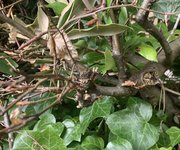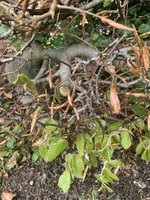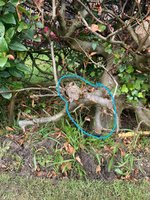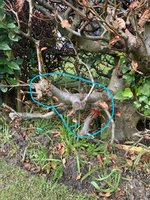ForeverRaynning
Yamadori
Hopefully this is the right subforum. I made a post in the ‘new to bonsai’ section and got some suggestions to try cuttings and air layering to propegate some local trees/plants whilst I wait on my seeds.
I went and had a look at the beech hedge we have and took some pictures, these are just some chunky bits I found, I have no idea what to really look for. Can see where they’ve been cut back before, 2 pictures are of the same piece just differant angles (marked in blue), noticed they seemed to have leaves on around the cut pieces which caught my attention. Its hard to take photos and also picture what a piece would look like off the hedge (or woth non-dead leaves!), its quite dense too so hard to see it from many angles, some of these pics I’m not even sure what parts I was specifically looking at (they’re relatively dense hedges, lots of smaller branches and old leaves busying up the pictures, maybe I need to photoshop the surroundings out).
I understand its probably difficult to work out if something would look good when its just a 2D photo, but i don’t want to be going after large chunks like this if they aren’t suitable, maybe the cut ends are an issue, maybe they’re too chunky, maybe the ‘trunk’ shape would just look odd, I have no idea.
Any input would be appreciated (but please keep criticism and comments as gentle as you can if possible). I may be going about this completely wrong.
I went and had a look at the beech hedge we have and took some pictures, these are just some chunky bits I found, I have no idea what to really look for. Can see where they’ve been cut back before, 2 pictures are of the same piece just differant angles (marked in blue), noticed they seemed to have leaves on around the cut pieces which caught my attention. Its hard to take photos and also picture what a piece would look like off the hedge (or woth non-dead leaves!), its quite dense too so hard to see it from many angles, some of these pics I’m not even sure what parts I was specifically looking at (they’re relatively dense hedges, lots of smaller branches and old leaves busying up the pictures, maybe I need to photoshop the surroundings out).
I understand its probably difficult to work out if something would look good when its just a 2D photo, but i don’t want to be going after large chunks like this if they aren’t suitable, maybe the cut ends are an issue, maybe they’re too chunky, maybe the ‘trunk’ shape would just look odd, I have no idea.
Any input would be appreciated (but please keep criticism and comments as gentle as you can if possible). I may be going about this completely wrong.




